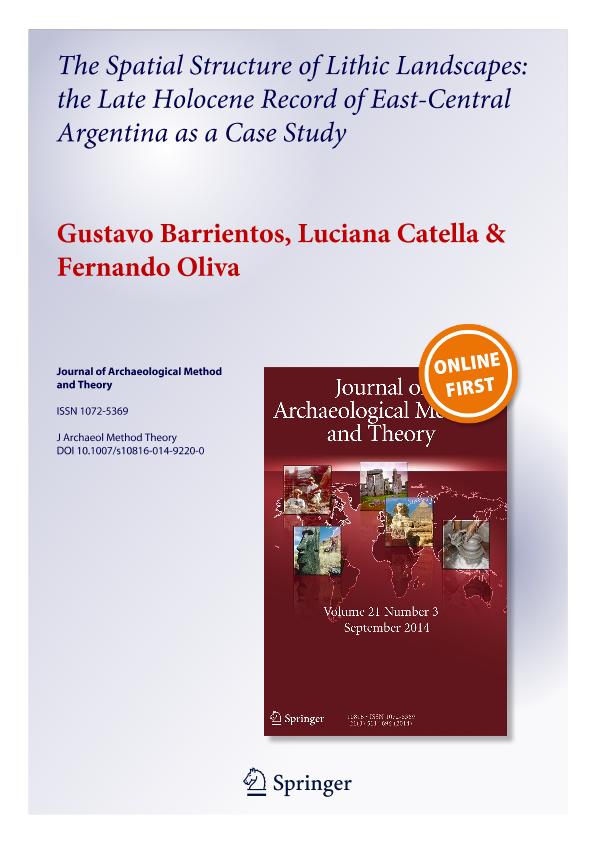Mostrar el registro sencillo del ítem
dc.contributor.author
Barrientos, Gustavo

dc.contributor.author
Catella, Luciana

dc.contributor.author
Oliva, Fernando Walter Pablo

dc.date.available
2018-08-03T18:45:36Z
dc.date.issued
2014-09
dc.identifier.citation
Barrientos, Gustavo; Catella, Luciana; Oliva, Fernando Walter Pablo; The Spatial Structure of Lithic Landscapes: the Late Holocene Record of East-Central Argentina as a Case Study; Springer; Journal of Archaeological Method and Theory; 22; 4; 9-2014; 1151-1192
dc.identifier.issn
1573-7764
dc.identifier.uri
http://hdl.handle.net/11336/54115
dc.description.abstract
The aim of this paper is to discuss conceptual and methodological issues related with the archaeological study of lithic landscapes and exemplify the approach with a case study (artifact distribution data from east-central Argentina). A lithic landscape—understood as the co-occurrence, in a given geographic space, of different structural units each one composed by a raw material source and the complete set of unmodified and human-modified pieces of rock extracted from that source and then transported, used, and discarded across the landscape (i.e., a scatter area)—can be modeled using kriging, a geostatistical interpolation tool useful for integrating scattered information into coherent spatial models. The case study allows for the examination and discussion of, on one hand, the relationships between the type and location of the sources and the size and shape of the respective scatter areas and, on the other, the reciprocal relationships between different raw materials and sources. It is concluded that a proper description of the spatial structure of a lithic landscape is the needed baseline from which to evaluate different explanatory models. Such models should take into account different sets of initial conditions and generative mechanisms, in order to cope with the pervasive problem of equifinality.
dc.format
application/pdf
dc.language.iso
eng
dc.publisher
Springer

dc.rights
info:eu-repo/semantics/openAccess
dc.rights.uri
https://creativecommons.org/licenses/by-nc-sa/2.5/ar/
dc.subject
Artifact Distributions
dc.subject
East-Central Argentina
dc.subject
Geostatistics
dc.subject
Late Holocene
dc.subject
Lithic Landscapes
dc.subject
Raw Material Sources
dc.subject.classification
Historia

dc.subject.classification
Historia y Arqueología

dc.subject.classification
HUMANIDADES

dc.title
The Spatial Structure of Lithic Landscapes: the Late Holocene Record of East-Central Argentina as a Case Study
dc.type
info:eu-repo/semantics/article
dc.type
info:ar-repo/semantics/artículo
dc.type
info:eu-repo/semantics/publishedVersion
dc.date.updated
2018-08-03T14:17:09Z
dc.journal.volume
22
dc.journal.number
4
dc.journal.pagination
1151-1192
dc.journal.pais
Estados Unidos

dc.journal.ciudad
Nueva York
dc.description.fil
Fil: Barrientos, Gustavo. Universidad Nacional de La Plata. Facultad de Cienicas Naturales y Museo. División Antropología; Argentina. Consejo Nacional de Investigaciones Científicas y Técnicas; Argentina
dc.description.fil
Fil: Catella, Luciana. Consejo Nacional de Investigaciones Científicas y Técnicas; Argentina. Universidad Nacional de Rosario. Facultad de Humanidades y Artes; Argentina. Universidad Nacional de La Plata. Facultad de Ciencias Naturales y Museo. División Arqueología; Argentina
dc.description.fil
Fil: Oliva, Fernando Walter Pablo. Universidad Nacional de Rosario. Facultad de Humanidades y Artes; Argentina
dc.journal.title
Journal of Archaeological Method and Theory
dc.relation.alternativeid
info:eu-repo/semantics/altIdentifier/doi/http://dx.doi.org/10.1007/s10816-014-9220-0
dc.relation.alternativeid
info:eu-repo/semantics/altIdentifier/url/https://link.springer.com/article/10.1007%2Fs10816-014-9220-0
Archivos asociados
